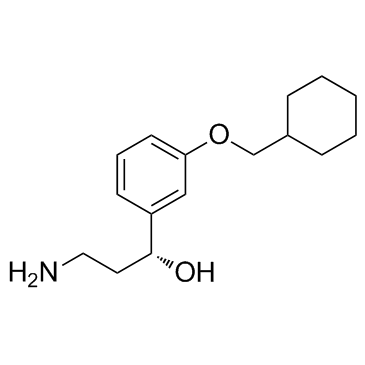| Description |
Emixustat, a novel visual cycle modulator, is an inhibitor of the visual cycle isomerase with an IC50 value of 4.4 nM in vitro.
|
| Related Catalog |
|
| Target |
IC50: 4.4 nM (visual cycle isomerase)[1]
|
| In Vitro |
Emixustat potently inhibits isomerase activity in vitro (IC50=4.4 nM). Treatment of emixustat shows a concentration dependent reduction of 11-cis-ROL production [1]. Emixustat strongly inhibits 11-cis-retinol production with an IC50 value of 232±3 nM[2].
|
| In Vivo |
Emixustat reduces the production of visual chromophore (11-cis retinal) in wild-type mice following a single oral dose (ED50=0.18mg/kg). In albino mice, emixustat is shown to be effective in preventing photoreceptor cell death caused by intense light exposure. Pre-treatment with a single dose of emixustat (0.3 mg/kg) provids a 50%protective effect against light-induced photoreceptor cell loss, while higher doses (1-3 mg/kg) are nearly 100%effective. In Abca4-/- mice, chronic (3 month) emixustat treatment markedly reduces lipofuscin autofluorescence and reduces A2E levels by 60%( ED50=0.47 mg/kg). In the retinopathy of prematurity rodent model, treatment with emixustat during the period of ischemia and reperfusion injury produces a 30%reduction in retinal neovascularization (ED50=0.46mg/kg)[1].
|
| Animal Admin |
Mice: Albino (BALB/c) mice are used to assess the effects of emixustat on protection from light damage. Mice are treated with a single dose of emixustat (0.3 mg/kg and 1.0 mg/kg). The effect of emixustat on the accumulation of A2E and lipofuscin autofluorescence is examined in Abca4-/- mice. Mice are treated with emixustat (3 months daily treatment, 0.3 or 3 mg/kg/day)[1].
|
| References |
[1]. Bavik C, et al. Visual Cycle Modulation as an Approach toward Preservation of Retinal Integrity. PLoS One. 2015 May 13;10(5):e0124940. [2]. Kiser PD, et al. Catalytic mechanism of a retinoid isomerase essential for vertebrate vision. Nat Chem Biol. 2015 Jun;11(6):409-15.
|
